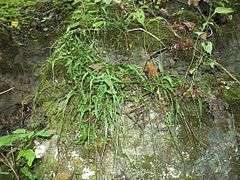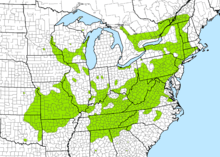Asplenium rhizophyllum
| Asplenium rhizophyllum | |
|---|---|
 | |
| Asplenium rhizophyllum on rocks in the Red River Gorge, Daniel Boone National Forest, Kentucky, USA. | |
| Scientific classification | |
| Kingdom: | Plantae |
| Division: | Pteridophyta |
| Class: | Pteridopsida |
| Order: | Polypodiales |
| Family: | Aspleniaceae |
| Genus: | Asplenium |
| Species: | A. rhizophyllum |
| Binomial name | |
| Asplenium rhizophyllum L. | |
| Synonyms | |
|
Antigramma rhizophylla (L.) J.Sm. | |
Asplenium rhizophyllum, the American Walking Fern, is a frequently-occurring fern native to North America. It is a close relative of Asplenium ruprechtii[2] (syn: Camptosorus sibiricus) which is found in East Asia and also goes by the common name of "walking fern".[3]
Description
Asplenium rhizophyllum is a small fern whose undivided, evergreen leaves and long, narrow tips, sometimes curving back and rooting, give it a highly distinctive appearance.
Roots and stipes
It does not spread and form new plants via the roots. The rhizome bears dark brown, narrowly triangular scales 2 to 3 millimetres (0.08 to 0.1 in) long and 0.5 to 1 millimetre (0.02 to 0.04 in) wide (occasionally as narrow as 0.2 millimetres (0.008 in)) with untoothed margins. The stipe (the part of the stem below the leaf blade) is 0.5 to 12 centimetres (0.20 to 4.7 in) long, and ranges from one-tenth to one and one-half times the length of the blade. The stipe is reddish-brown at the base, becoming green above. Scales like those of the rhizome are present at the stipe base, changing to tiny club-shaped hairs above.[2]
Leaves
The leaf blades are not subdivided, as in most other ferns, but are narrowly triangular to linear or lance-shaped. Their shape can be quite variable, even on the same plant. They measure from 1 to 30 centimetres (0.4 to 10 in) long and from 0.5 to 5 centimetres (0.2 to 2 in) across and have a leathery texture with sparse hairs, more abundant below than above. The rachis (leaf axis) is dull green in color and almost devoid of hairs. On the underside of the blade, the veins are difficult to see and anastomose (split and rejoin each other), forming a series of areoles (the small areas enclosed by the veins) near the rachis. Fertile fronds are usually larger than sterile fronds, but their shape is otherwise the same. The base of the blade is typically heart-shaped (with the stipe protruding from the cleft); the bulges on either side of the cleft are frequently enlarged into auricles (rounded lobes), or occasionally into sharply-pointed, tapering lobes. The leaf tips may be rounded but are typically very long and attenuate (drawn out); the attenuate tips are capable of sprouting roots and growing into a new plant when the tip touches a surface suitable for growth. On rare occasions, the auricles at the leaf base will also take on an attenuate shape and form roots at the tip.[2] The ability of the leaf tips to root and form a new plant at some distance from the parent gives the species its common name.
Sori and spores
Fertile fronds bear a large number of sori underneath, which are not arranged in any particular order. The sori are often fused where veins join. Each sporangium in a sorus carries 64 spores. The diploid sporophyte has a chromosome number of 72.[2]
Similar species
The leaf shape and proliferating tips easily distinguish A. rhizophyllum from most other ferns. Its hybrid descendants share the long-attenuate leaf tip, but are more deeply lobed. An artificial backcross between A. rhizophyllum and A. tutwilerae was closer to A. rhizophyllum in morphology, but still remained some lobes in the basal part of the blade, had a shallowly undulating, rather than smoothly curved, leaf edge in the apical part, showed a maroon color in the stipe up to the base of the leaf blade, and possessed the abortive spores of a sterile hybrid.[4] A. ruprechtii, the Asian walking fern, also possesses attenuate, proliferating tips, but has a lanceolate leaf blade, which tapers to a wedge at the base rather than forming a heart shape.[5]
The profile of the plant is usually not more than 5 cm (2 in) in height, but can be up to 15 cm (6 in) high.
Taxonomy
This species is commonly known as North American walking fern[6] or simply walking fern,[7] because the growth of new plants at the leaf tip allows it to "walk" across surfaces over several generations.
Linnaeus first gave the walking fern the binomial Asplenium rhizophyllum in his Species Plantarum of 1753.[8] In 1833, J.H.F. Link placed the species in a segregate genus, Camptosorus, because of the irregular arrangement of its sori (in contrast to the rest of Asplenium, where the sori are confined to the edge of veins).[9] John Smith did not feel that this character was sufficient to segregate it from the rest of Asplenium, but placed it in the genus Antigramma, another Asplenium segregate, on the basis of its reticulate venation, to the convolutions of which he attributed the soral arrangement.[10] It was commonly placed either in Asplenium and Camptosorus by later authors,[2] but phylogenetic studies have shown that Camptosorus is nested within Asplenium and its species should be treated as part of that genus.[11][12]
The name Asplenium rhizophyllum has also been applied to two other species; in current botanical practice, these are illegitimate later homonyms of Linnaeus' name of 1753. The first of these homonyms was created by Linnaeus himself in 1763, when he accidentally used the name twice, applying it first to his original taxon and again to a species from the West Indies which also proliferates at the leaf tips.[13] He had referred to the West Indian species as A. radicans in 1759,[14] the name by which it is known today.[15] In 1834, Gustav Kunze transferred the species Caenopteris rhizophylla to Asplenium without changing the epithet;[16] George Proctor identified this species, based on a specimen from Dominica, with A. conquisitum,[17] now synonymized with A. rutaceum.[18]
Hybrids
Walking fern is one of the three parental species of the "Appalachian Asplenium complex", a group of Asplenium hybrids and their progenitors known from eastern North America. Hybridization between walking fern and mountain spleenwort (A. montanum) has given rise through chromosome doubling to a new, fertile, species, lobed spleenwort (A. pinnatifidum). The sterile hybrid between walking fern and ebony spleenwort (A. platyneuron), known as Scott's spleenwort ( A. × ebenoides), may be found where the two parents are in contact; at one locality, in Havana Glen, Alabama, A. × ebenoides has undergone chromosome doubling to produce a fertile species, Tutwiler's spleenwort (A. tutwilerae).[19]
Much more rarely, walking fern hybridizes with two other common spleenworts of eastern North America. The hybrid between walking fern and wall-rue (A. ruta-muraria), known as unexpected spleenwort (A. × inexpectatum), is known from a single specimen collected on dolomite in Adams County, Ohio.[20] The hybrid between walking fern and maidenhair spleenwort, (A. trichomanes ssp. trichomanes), Shawnee spleenwort (A. × shawneense), is known from one collection on sandstone in the Shawnee Hills of Illinois.[21]
A triploid hybrid between walking fern and Tutwiler's spleenwort was accidentally produced in culture. A similar plant collected from limestone in Shepherdstown, West Virginia could have originated from the same parents, from an unreduced (diploid) gametophyte of Scott's spleenwort crossed with walking fern, or from an unreduced walking fern gametophyte crossed with ebony spleenwort.[4]
Distribution and habitat

This fern grows on alkaline to sub-acid rock, always in a moss bed. It is seen to best effect on limestone boulders and ledges, although it also grows on sandstone.
Cultivation
It was introduced into cultivation in England in 1680.[22] It prefers low to medium light levels, and a moist, basic potting mix.[6]
Citations
- ↑ NatureServe 2015.
- 1 2 3 4 5 Wagner, Moran & Werth 1993.
- ↑ Encyclopædia Britannica Online
- 1 2 Wagner & Boydston 1958.
- ↑ Lin & Viane 2013.
- 1 2 Hoshizaki & Moran 2001, p. 228.
- ↑ Cobb, Farnsworth & Lowe 2005, p. 74.
- ↑ Linnaeus 1753, p. 1078.
- ↑ Link 1833, p. 69.
- ↑ Smith 1842, pp. 176–177.
- ↑ Murakami et al. 1999.
- ↑ Schneider et al. 2004.
- ↑ Linnaeus 1763, p. 1540.
- ↑ Linnaeus 1759, p. 1323.
- ↑ Mickel & Smith 2004, p. 116.
- ↑ Kunze 1834, p. 71.
- ↑ Proctor 1965, p. 214.
- ↑ Mickel & Smith 2004, p. 118.
- ↑ Wagner 1954.
- ↑ Braun 1939.
- ↑ Moran 1981.
- ↑ Birkenhead 1890, p. 529.
Bibliography
- Birkenhead, J. (1890). "Hardy Ferns, and their Cultivation". Journal of the Royal Horticultural Society of London. n.s. v.12: 520–531.
- Braun, E. Lucy (1939). "A new fern hybrid". American Fern Journal 29 (4): 133–135. doi:10.2307/1545406.
- Hoshizaki, Barbara Joe; Moran, Robbin C. (2001). Fern Grower's Manual. Portland, Oregon: Timber Press. ISBN 9780881924954.
- Cobb, Boughton; Farnsworth, Elizabeth; Lowe, Cheryl (2005). A Field Guide to Ferns of Northeastern and Central North America. Peterson Field Guides. New York City: Houghton Mifflin. ISBN 0-618-39406-0.
- Kunze, Gustav (1834). "Synopsis plantarum Cryptogamicarum ab Ed. Poeppig in Cuba insula et in America meridionali collectarum" 9: 1–111.
- Lin, Youxing; Viane, Ronald (2013). Flora of China Editorial Committee, eds. Asplenium ruprechtii. Flora of China 2–3 (Science Press, Beijing and Missouri Botanical Garden Press).
- Link, Heinrich Friedrich (1833). Hortus Regius Botanicus Berolinensis 2. Berlin: G. Reimer.
- Linnaeus, C. (1753). Species Plantarum II (1st ed.). Stockholm: Laurentii Salvii.
- Linnaeus, C. (1759). Systema Naturae II (10th ed.). Stockholm: Laurentii Salvii.
- Linnaeus, C. (1763). Species Plantarum II (2nd ed.). Stockholm: Laurentii Salvii.
- Mickel, John T.; Smith, Alan R. (2004). Pteridophytes of Mexico Part I. Memoirs of the New York Botanical Garden 88. Bronx, New York: New York Botanical Garden Press. ISBN 978-0-89327-488-7.
- Moran, Robbin C. (1981). "×Asplenosorus shawneensis, a new natural fern hybrid between Asplenium trichomanes and Camptosorus rhizophyllus". American Fern Journal 71 (3): 85–89. doi:10.2307/1546733.
- Murakami, Noriaki; Nogami, Satoru; Watanabe, Mikio; Iwatsuki, Kunio (1999). "Phylogeny of Aspleniaceae inferred from rbcL nucleotide sequences". American Fern Journal 89: 232–243. doi:10.2307/1547233.
- "Asplenium rhizophyllum". NatureServe. January 2015. Retrieved November 22, 2015.
- Proctor, G. R. (1965). "Taxonomic notes on Jamaican ferns". British Fern Gazette 9 (6): 213–221.
- Schneider, Harald; Russell, Steve J.; Cox, Cymon J.; Bakker, Freek; Henderson, Sally; Rumsey, Fred; Barrett, John; Gibby, Mary; Vogel, Johannes C. (2004). "Chloroplast Phylogeny of Asplenioid Ferns based on rbcL and trnL-F Spacer Sequences (Polypodiidae, Aspleniaceae) and its Implications for Biogeography". Systematic Botany 29 (2): 260–274. doi:10.1600/036364404774195476.
- Smith, John (1842). "An arrangement and definition of the Genera of Ferns". Hooker's Journal of Botany 4: 147–198.
- Wagner, Warren H., Jr. (1954). "Reticulate Evolution in the Appalachian Aspleniums". Evolution 8: 103–118. doi:10.2307/2405636.
- Wagner, Warren H., Jr.; Boydston, Kathryn E. (1958). "A new hybrid spleenwort from artificial cultures at Fernwood and its relationship to a peculiar plant from West Virginia". American Fern Journal 48 (4): 146–159. doi:10.2307/1545451.
- Wagner, Warren H., Jr.; Moran, Robbin C.; Werth, Charles R. (1993). Flora of North America Editorial Committee, eds. Asplenium rhizophyllum. Flora of North America North of Mexico 2 (New York and Oxford: Oxford University Press).
Sources
- United States department of agriculture
- Hardy Fern Library
- Connecticut Botanical Society
- Plant Delights Nursery
- IPNI Listing
